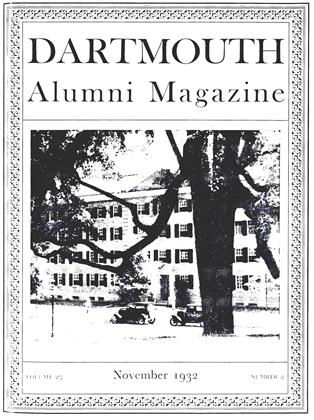By Harry E. Burton, Professorof Latin in Dartmouth College. Cambridge, Harvard University Press, 1932.Pp. 1-130, with four maps, bibliography,and index.
Professor Burton's widely known series of Latin texts lias attested his accurate scholarship and his conspicuous clarity of expression. In his new book one finds both these qualities at their best. Furthermore, he has chosen in his present subject one which is bound, I should think, to arouse interest in various quarters far outside the specialized field of Latin studies. Indeed it may not be too sanguine to hope that this book will even eradicate the abominable popular notion that the ancients believed the earth to be flat, for
. . in the third century before Christ Eratosthenes said that, if the Atlantic Ocean were not so large, one could sail around the earth, and Strabo, two centuries later, suggested the possibility of another continent between western Europe and eastern Asia, thus anticipating by 1500 years the discovery of America. As early as the sixth century before Christ Pythagoras had taught the spherical shape of the earth, and in this he was followed by Aristotle in the fourth century. It is probable that from this time educated persons in general believed that the earth was round. . . ."
The scheme of the book is easily explained: the arrangement wherever possible is chronological. After a short introduction dealing in general with the progress of ancient geography, the reader is given an apercu of the geographical knowledge of the Egyptians, the Cretans, and the Phoenicians. Chapters upon the voyage of the Argonauts and the geography of the Homeric Poems bring the author to Hecataeus, the voyage of Hanno, and Herodotus. There follows a summary of geographical progress between Herodotus and Alexander. Then the additions made to geographical knowledge by Alexander and his successors are discussed. The history of geography until this period is concerned largely with the coasts of the Mediterranean Sea and with the continent of Asia, but at this point the real discovery of western Europe began. The reader is told of the first serious attempts to use latitude and longitude by the geographers of the third and second centuries and of the importance of Roman military operations in adding to geographical knowledge. After treating the geographers of the first century B. C., the author comes to "the most important geographical work of antiquity," that of Strabo. Pomponius Mela, Pliny, the author of the Periplus of the Erythraean Sea, Marinus of Tyre, and, of course, Ptolemy are each given a chapter and the study ends with a succinct conclusion.
Throughout the book the author analyzes and estimates critically the knowledge possessed by the ancient writers on geography. Here he comments upon the really surprising extent and accuracy of their information and there upon the ignorance or credulity which these same writers display. There is interesting discussion of the various motives which led to exploration: conquest, love of adventure, scientific curiosity, the trade in tin and amber, etc. The pages are very fully documented with references to the works of the ancient writers on geography. Ancient place names are regularly followed by their modern equivalents where this practice is useful. The four new maps, about which more should be said, and the full index make reference easy. The typography and format of the book are exceptionally pleasing.
It is apparent that the history of ancient geography, despite its obvious importance, has been too rarely studied intensively by recent classical scholars. This omission may strike one as singular, but a plausible explanation is not far to seek: the subject presents for solution numerous difficulties demanding both shrewd acumen and patient research. The reviewer finds it appropriate and indeed fortunate that it is Professor Burton, for many years a student of the texts of the ancient geographers, who has seen fit to perform this genuine service to classical scholarship. Adequate examination of the technical aspects of this excellent study is naturally left to those scholars who will review it for the columns of the classical periodicals.
Mr. Harry Eisenbrown is the author of "Die Verwendung der Tiernamen in der Sprache der englischen Tecknik" a dissertation for the degree of Doctor of Philosophy, presented at Heidelberg in 1932.
Mr. Lawrence B. Leighton is the author of an article in the July-September issue of Hound and Horn "An Autopsy and a Prescription."
"Evidence for the Constitution of the Ether" by Professor James Mackaye has been reprinted from the July issue of the Journal of the Franklin Institute.
The August 18 issue of the Journal ofPhilosophy contains an article by Dr. A. Myrton Frye "Intellectual and Moral Obligations."
The Psychological Review for September contains an article "Adrenalin and Emotion" by Mr. Carney Landis and Dr. William A. Hunt '28.
 View Full Issue
View Full Issue
More From This Issue
-
 Article
ArticleTHE PERSONALITY OF WEBSTER
November 1932 By Claude M. Fuess -
 Article
ArticleHANOVER BROWSING
November 1932 By Rees Higgs Bowen -
 Sports
SportsTHIS GAME OF FOOTBALL
November 1932 By Edwin B. Dooley -
 Article
ArticleEditorial Comment on the Opening Address
November 1932 -
 Article
ArticleTHE CLASS OF 1936
November 1932 By E. Gordon Bill -
 Class Notes
Class NotesClass of 1930
November 1932 By Albert I. Dickerson
John Barker Stearns
Books
-
 Books
BooksFACULTY PUBLICATIONS
April 1941 -
 Books
BooksTHE BEASTS & THE ELDERS.
January 1974 By ALEXANDER G. MEDLICOTT JR. '50 -
 Books
BooksFLAUBERT IN EGYPT: A SENSIBILITY ON TOUR. A NARRATIVE DRAWN FROM GUSTAVE FLAUBERT'S TRAVEL NOTES & LETTERS
December 1973 By JOHN HURD '21 -
 Books
BooksA TAX PROGRAM FOR A SOLVENT AMERICA, >
December 1945 By Lloyd P. Rice -
 Books
BooksNotes on justice finally done and old tales long in the telling.
May 1977 By R.H.R. '38 -
 Books
BooksMIGRATION FROM VERMONT (1776- 1860)
October 1937 By Richard F. Upton '35


